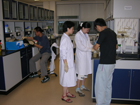 王晓东博士 北京生命科学研究所资深研究员 电话: 010-80726688-8501 传真: 010-80726673 Room Number:B203 E-mail: wangxiaodong@nibs.ac.cn
研究概述: 我们的研究目标是在分子水平上理解细胞凋亡----一种细胞内固有的自身消亡的生化过程。同时,我们还希望在人类疾病如癌症中精确地找到这一基础生化过程的缺陷,并根据我们从研究中获得的信息来设计相应的治疗策略。 Publications: 1. Xiaodong Wang and Richard A. Padgett (1989). Hydroxyl radical "footprinting" of RNA: application to pre-mRNA splicing complexes. Proc. Natl. Acad. Sci. USA. 86, 7795-7799. 2. Michael R. Briggs, Chieko Yokoyama, Xiaodong Wang, Michael S. Brown, and Joseph L. Goldstein (1993). Nuclear protein that binds sterol regulatory element of low-density lipoprotein receptor promotor I. Identification of the protein and delineation of its target nucleotide sequence. J. Biol. Chem. 268, 14490-14496. 3. Xiaodong Wang, Michael R. Briggs, Xianxin Hua, Chieko Yokoyama, Joseph L. Goldstein, and Michael S. Brown (1993). Nuclear protein that binds sterol regulatory element of low-density lipoprotein receptor promotor II. Purification and characterization. J. Biol. Chem. 268, 14497-14504. 4. Chieko Yokoyama, Xiaodong Wang, Michael R. Briggs, Arie Admon, Jian Wu, Xianxin Hua, Joseph L. Goldstein, and Michael S. Brown (1993). SREBP-1, a basic helix-loop-helix leucine zipper protein that controls transcription of the LDL receptor gene. Cell 75, 187-197. 5. Xianxin Hua, Chieko Yokoyama, Jian Wu, Michael R. Briggs, Michael S. Brown, Joseph L. Goldstein, and Xiaodong Wang (1993). SREBP-2, a second basic helix-loop-helix leucine zipper protein that stimulates transcription by binding to a sterol regulatory element. Proc. Natl. Acad. Sci. USA. 90, 11603-11607. 6. Xiaodong Wang, Ryuichiro Sato, Michael S. Brown, Xianxin Hua, and Joseph L. Goldstein (1994). SREBP-1, a membrane-bound transcription factor released by sterol-regulated proteolysis. Cell 77, 53-62. 7. Ryuichiro Sato, Jianxin Yang, Xiaodong Wang, Mark J. Evans, Y.K. Ho, Joseph L. Goldstein, and Michael S. Brown (1994). Assignment of the membrane attachment, DNA binding, and transcriptional activation domains of sterol regulatory element binding protein-1 (SREBP-1). J. Biol. Chem. 269, 17267-17273. 8. Xiaodong Wang, Jih-tung Pai, Elizabeth A. Wiedenfeld, Clive A. Slaughter, Julio Medina, Joseph L. Goldstein, and Michael S. Brown (1995). Purification of an ICE-related cysteine protease that cleaves sterol-regulatory element binding proteins between the leucine zipper and transmembrane domains. J. Biol. Chem. 270, 18044-18050. 9. Xiaodong Wang, Nikolai G. Zelenski, Jianxin Yang, Juro Sakai, Michael S. Brown, and Joseph L. Goldstein (1996). Cleavage of sterol regulatory element binding proteins (SREBPs) by CPP32 during apoptosis. EMBO J. 15, 1012-1020. 10. Xuesong Liu, Caryn Naekyung Kim, Jan Pohl and Xiaodong Wang (1996). Purification and characterization of an interleukin-1?-converting enzyme family protease that activates cysteine protease P32 (CPP32). J. Biol. Chem. 271, 13371-13376. 11. Xuesong Liu, Caryn Naekyung Kim, Jie Yang, Ronald Jemmerson, and Xiaodong Wang (1996). Induction of apoptotic program in cell-free extracts: requirement for dATP and cytochrome c. Cell 86, 147-157. 12. Jie Yang, Xuesong Liu, Kapil Bhalla, Caryn Naekyung Kim, Ana Maria Ibrado, Jiyang Cai, Tsung-I Peng, Dean P. Jones and Xiaodong Wang. (1997). Prevention of apoptosis by Bcl-2: release of cytochrome c from mitochondria blocked. Science 275, 1129-1132. 13. Xuesong Liu, Hua Zou, Clive Slaughter, and Xiaodong Wang. (1997). DFF, a heterodimeric protein that functions downstream of caspase-3 to trigger DNA fragmentation during apoptosis. Cell 89, 175-184. 14. Hua Zou, William J. Henzel, Xuesong Liu, Alexis Lutschg, and Xiaodong Wang. (1997) Apaf-1, a human protein homologous to C. elegans CED-4, participates in cytochrome c-dependent activation of caspase-3. Cell 90, 405-413. 15. Kim, C. N., Wang, X., Huang, Y., Ibrado, A. M., Liu, L., Fang, G., and Bhalla, K. (1997). Overexpression of Bcl-X(L) inhibits Ara-C-induced mitochondrial loss of cytochrome c and other perturbations that activate the molecular cascade of apoptosis. Cancer Res. 57, 3115-3120. 16. Peng Li, Deepak Nijhawan, Imawati Budihardjo, Srinivasa M. Srinivasula, Manzoor Ahmad, Emad S. Alnemri, and Xiaodong Wang (1997). Cytochrome c and dATP-dependent formation of Apaf-1/caspase-9 complex initiates an apoptotic protease cascade. Cell 91, 479-489. 17. Toh, S.Y., Wang, X.D., and Li, P. (1998). Identification of the nuclear factor HMG2 as an activator for DFF nuclease activity. BBRC. 250, 598-601. 18. Xuesong Liu, Peng Li, Piotr Widlak, Hua Zou, Xu Luo, William T. Garrard, and Xiaodong Wang (1998). The 40-kDa subunit of DNA fragmentation factor induces DNA fragmentation and chromatin condensation during apoptosis. Proc. Natl. Acad. Sci. USA. 95, 8461-846. 19. Lorenzo M. Leoni, Qi Chao, Howard B. Cottam, Davide Genini, Michael Rosenbach, Carlos J. Carrera, Imawati Budihardjo, Xiaodong Wang, and Dennis A. Carson (1998). Induction of an apoptotic program in cell free extracts by 2-chloro 20. Xu Luo, Imawati Budihardjo, Hua Zou, Clive Slaughter, and Xiaodong Wang (1998). Bid, a Bcl-2 interacting protein, mediates cytochrome c release from mitochondria in response to activation of cell surface death receptors. Cell 94, 481-490. 21. Jianhua Zhang, Xuesong Liu, David C. Scherer, Gregory P. Boivin, Luc Van Kaer, Xiaodong Wang, and Ming Xu (1998). Resistance to DNA fragmentation and normal development in mice lacking the DNA fragmentation factor 45. Proc. Natl. Acad. Sci. USA. 95, 12480-12485. 22. Hua Zou, Yuchen Li, Xuesong Liu, and Xiaodong Wang (1999). An Apaf-1/cytochrome c multimeric complex is a functional apoptosome that activates procaspase-9. J. Biol. Chem. 274, 11549-11556. 23. Xuesong Liu, Hua Zou, Piotr Widlak, William Garrard, and Xiaodong Wang (1999). Activation of the apoptotic endonuclease DFF40 (CAD/CPAN): oligomerization and direct interaction with histone H1. J. Biol. Chem. 274, 13836-13840. 24. Cherie Purring, Hua Zou, Xiaodong Wang, and George McLendon (1999). Stoichiometry, free energy, and kinetic aspects of cytochrome c:Apaf-1 binding in apoptosis. J AC S 121, 7435-7436. 25. 26. Imawati Budihardjo, Holt Oliver, Michael Lutter, Xu Luo, and Xiaodong Wang (1999). Biochemical pathways of caspases activation during apoptosis. Annual Review of Cell and Developmental Biology. 15, 269-290. 27. Deepak Nijhawan, Narimon Honarpour, and Xiaodong Wang (2000). Apoptosis in neural development and disease. Annual Review of Neuroscience. 23, 73-87 28. Xuesong Liu and Xiaodong Wang (2000). In vitro assays for caspase-3 activation and DNA fragmentation. Methods in Enzymology, 322, 177-182 29. Narimon Honarpour, Chunying Du,, James A. Richardson, Robert E. Hammer, Xiaodong Wang, and Joachim Herz (2000). Adult Apaf-1 deficient mice exhibit male infertility. Dev. Biol. 218, 248-258. 30. Piotr Widlak, Peng Li, Xiaodong Wang, and William T. Garrard (2000). Cleavage preferences of the apoptotic endonuclease DFF40 (caspase-activated DNase or nuclease) on naked DNA and chromatin substrates. J. Biol. Chem. 275, 8226-8232. 31. Kang Li, Yucheng Li, John M. Shelton, James A. Richardson, Erika Spencer, Zhijian J. Chen, Xiaodong Wang, and R. Sanders Williams (2000). Cytochrome c deficiency causes embryonic lethality and attenuates stress-induced apoptosis. Cell 101, 389–399. 32. Davide Genini, Imawati Budihardjo, William Plunkett, Xiaodong Wang, Carlos J. Carrera, Howard B. Cottam, Dennis A. Carson, and Lorenzo M. Leoni. (2000). Nucleotide Requirements for the in Vitro Activation of the Apoptosis Protein-activating Factor-1-mediated Caspase Pathway. J. Biol. Chem. 275, 29-34. 33. Dori, A. Thomas, Chunying du, Ming Xu, Xiaodong Wang, and Timothy J. Ley (2000). DFF45/ICAD can be directly processed by Granzyme B duirng the induction of apoptosis. Immunity 12, 621-632. 34. Chunying Du, Min Fang, Yucheng Li, Lily Li, and Xiaodong Wang (2000). Smac, a mitochondrial protein that promotes cytochrome c-dependent caspase activation by eliminating IAP inhibition. Cell 102, 33-42. 35. Michael Lutter, Min Fang, Xu Luo, Masahiro Nishijima, Xiao-song Xie, and Xiaodong Wang (2000). Cardiolipin provides specificity for Bid targeting to mitochondria. Nature Cell Biol. 2, 754-756. 36. Jijie Chai, Chunying Du, Jia-Wei Wu, Saw Kyin, Xiaodong Wang, and Yigong Shi (2000). Structural and biochemical basis of apoptotic activation by Smac/DIABLO. Nature 406, 855-862. 37. Xuejun Jiang and Xiaodong Wang (2000). Cytochrome c promotes caspase-9 activation by inducing nucleotide binding to Apaf-1. J. Biol. Chem. 275, 31199-31203. 38. Geng Wu, Jijie Chai, Tomeka Suber, Jia-Wei Wu, Chunying Du, Xiaodong Wang, and Yigong Shi (2000). Structural basis of IAP recognition by Smac/DIABLO. Nature 408, 1008-1012. 39. Tianning Yu, Xiaodong Wang, Cherie Purring-Koch, Yen Wei, and George L. McLendon (2001). A Mutational epitope for proapoptotic cytochrome c binding to the apoptotic protease activation factor-1(Apaf-1). J. Biol. Chem. 276, 13034-13038. 40. Marisan Mejillano, Masaya Yamamoto, Andrew L Rozelle, Hui-Qiao Sun, Xiaodong Wang, and Helen L Yin (2001). Regulation of apoptosis by phosphatidylinositol 4, 5 Bisphosphate inhibition of caspases, and caspase inactivation of phosphatidylinositol phosphate 5 kinases. J. Biol. Chem. 276, 1865-1872. 41. Lily Y. Li, Xu Luo, and Xiaodong Wang (2001) Endonuclease G (EndoG) is an apoptotic DNase when released from Mitochondria. Nature 412, 95-99. 42. Jay Parrish, Lily Li, Kristina Klotz, Duncan Ledwich, Xiaodong Wang and Ding Xue (2001) The C. elegans mitochondrial nuclease Endonuclease G is important for DNA fragmentation and progression of apoptosis. Nature 412, 90-94. 43. Narimon Honarpour, Sandra Gilbert, Bruce Lahn, Xiaodong Wang, and Joachim Herz (2001) Apaf-1 deficiency and neural tube closure defects are found in fog mice. Proc. Natl. Acad. Sci. USA. 98, 9683-9687. 44. Piotr Widlak, Lily Y. Li, Xiaodong Wang, and William T. Garrard (2001) Action of recombinant human apoptotic endonuclease G on naked DNA and chromatin substrates: Cooperation with exonuclease and DNase I. J. Biol. Chem. 276, 48404-48409. 45. Michael Lutter, Guy Perkins, Xiaodong Wang (2001). The pro-apoptotic Bcl-2 family member tBid localizes to mitochondrial contact site. BMC Cell Biology 2, 22. 46. Xiaodong Wang (2001). The expanding role of mitochondria in apoptosis. Genes & Dev. 15, 2922-2933. 47. Jonathan P. Carson, Marcelina Behnam, Jennifer N. Sutton, Chunying Du, Xiaodong Wang, Donald F. Hunt, Michael J. Weber, and George Kulik. (2002). Smac Is Required for Cytochrome c-induced Apoptosis in Prostate Cancer LNCaP Cells. Cancer Res. 62. 18-23. 48. Devrim Acehan, Xuejun Jiang, David Gene Morgan, John E. Heuser, Xiaodong Wang and Christopher W. Akey (2002). Three-dimensional structure of the apoptosome: implications for assembly, procaspase-9 binding, and activation. Mol. Cell 9. 423-432. 49. Hitoshi Okada, Woong-Kyung Suh, Jianping Jin, Minna Woo, Chunying Du, Andrew Elia, Gordon 50. Mohanish Deshmukh, Chunying Du, Xiaodong Wang, and Eugene M. Johnson, Jr. (2002). Exogenous Smac induces competence and permits caspase activation in sympathetic neurons. J. Neurosci. 22, 8018-8027. 51. Xuejun Jiang, Hyun-Eui Kim, Hongjun Shu, Yingmin Zhao, Haichao Zhang, James Kofron, Jennifer Donnelly, Dave Burns, Shi-chung Ng, Saul Rosenberg, and Xiaodong Wang (2003). Distinctive roles of PHAP proteins and prothymosin-? in a death Regulatory Pathway. Science 299, 223-226. 52. Deepak Nijhawan, Min Fang, Elie Traer, Qing Zhong, Wenhua Gao, Fenghe Du and Xiaodong Wang (2003). Elimination of Mcl-1 is required for the initiation of apoptosis following ultraviolet irradiation. Genes & Dev. 17, 1475-1486. 53. Qinghua Liu, Tim A. Rand, Savitha Kalidas, Fenghe Du, Hyun-Eui Kim, Dean P. Smith and (2003). R2D2, a bridge between the initiation and effector steps of the Drosophila RNAi pathway. Science 301, 1921-1925. 54. Jianhua Zhang, Mei Dong, Lily Li, Yunxia Fan, Purnima Pathre, Jin Dong, Danwen Lou, James M. Wells, Danyvid Olivares-Villagómez, Luc Van Kaer, Xiaodong Wang, and Ming Xu (2003). Endonuclease G is required for early embryogenesis and normal apoptosis in mice. Proc. Natl. Acad. Sci. USA.100, 15782-15787. 55. Lin Li, Ranny Mathew Thomas, Hidetaka Suzuki, Jef K. De Brabander, Xiaodong Wang, Patrick G. Harran, "A Small Molecule Smac Mimic Potentiates TRAIL- and TNF-Mediated Cell Death" Science, 305(5689):1471-1474, September 2004 56. Xuejun Jiang and (2004). Cytochrome c-mediated apoptosis. Annual Review of Biochemistry. In Press. 57. Peng Li, Deepak Nijhawan, and Xiaodong Wang (2004). Mitochondrial activation of apoptosis. Cell 116, S57-59. 58. Zhenyue Hao, Gordon S. Duncan, Chia-Che Chang, Andrew Elia, Min Fang, Andrew Wakeham, itoshi Okada, Thomas Calzascia, YingJu Jang, Annick You-Ten, Wen-Chen Yeh, Pamela Ohashi, Xiaodong Wang, and Tak W. Mak (2005). Specific Ablation of the Apoptotic Functions of Cytochrome c Reveals a Differential Requirement for Cytochrome c and Apaf 59. Qing Zhong, Wenhua Gao, Fenghe Du, and Xiaodong Wang (2005). Mule/ARF-BP1, a BH3-Only E3 Ubiquitin Ligase, Catalyzes the Polyubiquitination of Mcl-1 and Regulates Apoptosis. Cell, 121, 1085–1095 (责任编辑:泉水) |
王晓东实验室(XiaoDong Wang)
时间:2004-03-17 13:00来源:本站原创 作者:admin 点击:
2900次
顶一下
(9)
100%
踩一下
(0)
0%
------分隔线----------------------------
- 发表评论
-
- 最新评论 进入详细评论页>>
- 推荐内容
-
- Jun Yang,Ph.D.
un Yang, Ph.D. Assistant Professor in Ophthalmology and Visual Sciences Adjunct...
- 仇子龙 研究员
Qiu, Zi-Long 仇子龙 Ph.D. zqiu@@ion.ac.cn 仇子龙: 1994-1998年就读于上海...
- 李澄宇 研究员
Li, Cheng-Yu, Ph.D. Investigator tonylicy@ion.ac.cn 李澄宇博士,1995-1999年就...
- 俞立受聘清华大学生物系教授
俞立 俞立1972年生,2008年9月回国工作,任生物系教授。1994年获...
- 马兰教授——2009年候选院士
生物通 编者按:我国的院士评选是从1955年开始的,在正常情况...
- 31岁颜宁受聘清华大学医学院教授
颜宁 1977年11月生,1996年进入清华大学生物科学与技术系, 200...
- Jun Yang,Ph.D.


